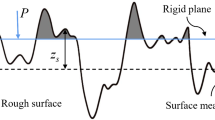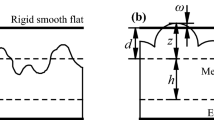Abstract
Hyperelastic materials like gels and rubbers have numerous applications in daily life and industrial production. However, most traditional contact models for rough solids do not include the hyperelastic deformation mechanism. This paper extends the linear-elastic incremental equivalent contact model to study the contact processes of hyperelastic rough solids. For any specific surface separation, the contact stiffness is determined by the total area and number of the contact patches, as well as the instantaneous tangent modulus. Analogous to buckle theory, we introduce the hyperelasticity of materials through employing the tangent modulus. By integrating the stiffness of contact spots, the normal contact force is then obtained. The load-area relation predicted by the present model exhibits consistency with finite element results even up to a contact area fraction of 90%. For hyperelastic solids with self-affine fractal rough surfaces, we investigate the effect of surface morphologies and material nonlinearity on contact behaviors. This research will be helpful for further studies on the lubrication, leakage, and wear of contact interfaces.








Similar content being viewed by others
Data Availability
All data included in this study are available upon request by contact with the corresponding author.
References
Creton, C., Ciccotti, M.: Fracture and adhesion of soft materials: a review. Rep. Prog. Phys. 79, 0466601 (2016). https://doi.org/10.1088/0034-4885/79/4/046601
Dunn, A.C., Sawyer, W.G., Angelini, T.E.: Gemini interfaces in aqueous lubrication with hydrogels. Tribol. Lett. 54, 59–66 (2014). https://doi.org/10.1007/s11249-014-0308-1
Tiwari, A., Dorogin, L., Bennett, A.I., Schulze, K.D., Sawyer, W.G., Tahir, M., Heinrich, G., Persson, B.N.J.: The effect of surface roughness and viscoelasticity on rubber adhesion. Soft Matter. 13, 3602–3621 (2017). https://doi.org/10.1039/c7sm00177k
Liu, R., He, L., Cao, M., Sun, Z., Zhu, R., Li, Y.: Flexible temperature sensors. Front. Chem. 9, 539678 (2021). https://doi.org/10.3389/fchem.2021.539678
Froyen, A.A.F., Schenning, A.P.H.J.: A multifunctional structural coloured electronic skin monitoring body motion and temperature. Soft Matter. 19, 361–365 (2023). https://doi.org/10.1039/d2sm01503j
Li, Xuebing, Wei, Yintao: Classic strain energy functions and constitutive tests of rubber-like materials. Rubber Chem. Technol. 88, 604–627 (2015)
Greenwood, J.A., Williamson, J.B.: Contact of nominally flat surfaces. Proc. R. Soc. Lon. Series a Math. Phys. Eng. Sci. 295, 300–319 (1966). https://doi.org/10.1098/rspa.1966.0242
Whitehouse, D.J., Archard, J.F.: Properties of random surfaces of significance in their contact. Proc. R. Soc. Lon. Series a Math. Phys. Eng. Sci. 316, 97–121 (1970). https://doi.org/10.1098/rspa.1970.0068
Hisakado, T.: Effect of surface-roughness on contact between solid-surfaces. Wear 28, 217–234 (1974). https://doi.org/10.1016/0043-1648(74)90163-x
Bush, A.W., Gibson, R.D., Thomas, T.R.: Elastic contact of a rough surface. Wear 35, 87–111 (1975). https://doi.org/10.1016/0043-1648(75)90145-3
Bush, A.W., Gibson, R.D., Keogh, G.P.: Strongly anisotropic rough surfaces. J. Tribol. 101, 15 (1979)
Afferrante, L., Carbone, G., Demelio, G.: Interacting and coalescing hertzian asperities: a new multiasperity contact model. Wear 278, 28–33 (2012). https://doi.org/10.1016/j.wear.2011.12.013
Afferrante, L., Bottiglione, F., Putignano, C., Persson, B.N.J., Carbone, G.: Elastic contact mechanics of randomly rough surfaces: an assessment of advanced asperity models and persson’s theory. Tribol. Lett. (2018). https://doi.org/10.1007/s11249-018-1026-x
Violano, G., Afferrante, L.: On the contact between elasto-plastic media with self-affine fractal roughness. Int. J. Mech. Sci. 255, 108461 (2023). https://doi.org/10.1016/j.ijmecsci.2023.108461
Mandelbrot, B.B.: The fractal geometry of nature. Fractal Geom. Nat. 51, 286–287 (1982)
Persson, B.N.J.: Theory of rubber friction and contact mechanics. J. Chem. Phys. 115, 3840–3861 (2001). https://doi.org/10.1063/1.1388626
Wang, G.F., Liang, X.M., Yan, D.: An incremental equivalent circular contact model for rough surfaces. J. Tribol. 143, 081503 (2021). https://doi.org/10.1115/1.4050602
Liang, X.M., Ding, Y., Duo, Y., Yuan, W.K., Wang, G.F.: Elastic-perfectly plastic contact of rough surfaces: an incremental equivalent circular model. J. Tribol. 144, 1–19 (2022). https://doi.org/10.1115/1.4051979
Liang, X.M., Jiang, C.Y., Wang, M.R., Dai, W.L., Wang, G.F.: Experimental study on the load-area relation of rough surfaces and comparison with theoretical model. Eur. J. Mech. A-Solids 99, 104934 (2023). https://doi.org/10.1016/j.euromechsol.2023.104934
Zhang, M.G., Cao, Y.P., Li, G.Y., Feng, X.Q.: Spherical indentation method for determining the constitutive parameters of hyperelastic soft materials. Biomech. Model. Mechanobiol. 13, 1–11 (2014). https://doi.org/10.1007/s10237-013-0481-4
Zhang, M.G., Chen, J.J., Feng, X.Q., Cao, Y.P.: On the applicability of sneddon’s solution for interpreting the indentation of nonlinear elastic biopolymers. J. Appl. Mech. 81, 091011 (2014). https://doi.org/10.1115/1.4027973
Zhang, Q., Yang, Q.S.: Effects of large deformation and material nonlinearity on spherical indentation of hyperelastic soft materials. Mech. Res. Commun. 84, 55–59 (2017). https://doi.org/10.1016/j.mechrescom.2017.06.003
Guo, Y., Li, J.A., Zhu, B., Li, Y.H.: Nonlinear dynamical model of hyperelastic pipes conveying fluid with finite deformation: roles of hyperelasticity and nonlinearity. Nonlinear Dyn. (2023). https://doi.org/10.1007/s11071-023-08584-7
Lengiewicz, J., de Souza, M., Lahmar, M.A., Courbon, C., Dalmas, D., Stupkiewicz, S., Scheibert, J.: Finite deformations govern the anisotropic shear-induced area reduction of soft elastic contacts. J. Mech. Phys. Solids 143, 104056 (2020). https://doi.org/10.1016/j.jmps.2020.104056
Shanley, F.R.: Inelastic column theory. J. Aeronaut. Sci. 14, 261–268 (1947). https://doi.org/10.2514/8.1346
Hill, R.: A general theory of uniqueness and stability in elastic-plastic solids. J. Mech. Phys. Solids 6, 236–249 (1958). https://doi.org/10.1016/0022-5096(58)90029-2
Hill, R.: Uniqueness criteria and extremum principles in self-adjoint problems of continuum mechanics. J. Mech. Phys. Solids 10, 185–194 (1962). https://doi.org/10.1016/0022-5096(62)90037-6
Hill, R.: Aspects of invariance in solid mechanics-sciencedirect. Adv. Appl. Mech. 18, 1–75 (1979)
Zhang, J., Zhang, Z.X., Huang, C.P.: Tensor presentation of algorithmic tangent modulus for plastic-damage models. Appl. Mech Mech Eng 29–32, 1747–1752 (2010)
Jiang, C.Y., Yuan, W.K., Zheng, Y.B., Wang, G.F.: Contact of rough surfaces: an incremental model accounting for strain gradient plasticity. Lubricants 11, 140 (2023). https://doi.org/10.3390/lubricants11030140
Abbott, E.J., Firestone, F.A.: Specifying surface quality-a method based on accurate measurement and comparison. J. Mech. Eng. 55, 569–572 (1933)
Zhai, C.P., Hanaor, D., Gan, Y.X.: Contact stiffness of multiscale surfaces by truncation analysis. Int. J. Mech. Sci. 131, 305–316 (2017). https://doi.org/10.1016/j.ijmecsci.2017.07.018
Sneddon, I.N.: Boussinesq’s problem for a flat-ended cylinder. Math. Proc. Cambridge Philos. Soc. 42, 29–39 (1946)
Sang, J.B., Sun, L.F., Xing, S.F., Liu, B.H., Sun, Y.L.: Mechanical properties of polymer rubber materials based on a new constitutive model. Polym. Polym. Compos. 22, 693–698 (2014). https://doi.org/10.1177/096739111402200807
Wang, S.H., Yuan, W.K., Liang, X.M., Wang, G.F.: A new analytical model for the flattening of gaussian rough surfaces. Eur. J. Mech. A-Solids (2022). https://doi.org/10.1016/j.euromechsol.2022.104578
Shisode, M., Hazrati, J., Mishra, T., De Rooij, M., van den Boogaard, T.: Evolution of real area of contact due to combined normal load and sub-surface straining in sheet metal. Friction 9, 840–855 (2021). https://doi.org/10.1007/s40544-020-0444-6
Mergel, J.C., Sahli, R., Scheibert, J., Sauer, R.A.: Continuum contact models for coupled adhesion and friction. J. Adhes. 95, 1101–1133 (2019). https://doi.org/10.1080/00218464.2018.1479258
Wadwalkar, S.S., Jackson, R.L., Kogut, L.: A study of the elastic-plastic deformation of heavily deformed spherical contacts. J. Eng. Tribol. 224, 1091–1102 (2010). https://doi.org/10.1243/13506501jet763
Hyun, S., Pei, L., Molinari, J.F., Robbins, M.O.: Finite-element analysis of contact between elastic self-affine surfaces. Phys. Rev. E 70, 26117–26117 (2004). https://doi.org/10.1103/PhysRevE.70.026117
Pei, L., Hyun, S., Molinari, J.F., Robbins, M.O.: Finite element modeling of elasto-plastic contact between rough surfaces. J. Mech. Phys. Solids 53, 2385–2409 (2005). https://doi.org/10.1016/j.jmps.2005.06.008
Bouchaud, E.: Scaling properties of cracks. J. Condens. Matter Phys. 9, 4319–4344 (1997). https://doi.org/10.1088/0953-8984/9/21/002
Krim, J., Palasantzas, G.: Experimental-observations of self-affine scaling and kinetic roughening at submicron lengthscales. Int. J. Mod. Phys. B 9, 599–632 (1995). https://doi.org/10.1142/s0217979295000239
Meakin, P. Fractals.: scaling and growth far from equilibrium. Cambridge University Press, Cambridge (1999)
Schmahling, J., Hamprecht, F.A.: Generalizing the abbott-firestone curve by two new surface descriptors. Wear 262, 1360–1371 (2007). https://doi.org/10.1016/j.wear.2007.01.025
Funding
This research was funded by the National Natural Science Foundation of China (Grant numbers 11525209).
Author information
Authors and Affiliations
Contributions
CJ and XL contributed to the study’s conception and design. FEM simulations and analysis were performed by CJ. The first draft of the manuscript was written by CJ and all authors commented on previous versions of the manuscript. All authors read and approved the final manuscript.
Corresponding author
Ethics declarations
Conflict of interest
The authors have no relevant financial or non-financial interests to disclose.
Additional information
Publisher's Note
Springer Nature remains neutral with regard to jurisdictional claims in published maps and institutional affiliations.
Rights and permissions
Springer Nature or its licensor (e.g. a society or other partner) holds exclusive rights to this article under a publishing agreement with the author(s) or other rightsholder(s); author self-archiving of the accepted manuscript version of this article is solely governed by the terms of such publishing agreement and applicable law.
About this article
Cite this article
Jiang, C., Liang, X. An Incremental Contact Model for Hyperelastic Solids with Rough Surfaces. Tribol Lett 72, 1 (2024). https://doi.org/10.1007/s11249-023-01800-w
Received:
Accepted:
Published:
DOI: https://doi.org/10.1007/s11249-023-01800-w




